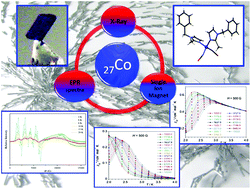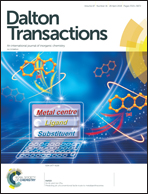The influence of pseudohalide ligands on the SIM behaviour of four-coordinate benzylimidazole-containing cobalt(ii) complexes†
Abstract
Three, mononuclear complexes of the formula [Co(bmim)2(SCN)2] (1), [Co(bmim)2(NCO)2] (2) and [Co(bmim)2(N3)2] (3) [bmim = 1-benzyl-2-methylimidazole] were prepared and structurally analyzed by single-crystal X-ray crystallography. The cobalt(II) ions in 1–3 are tetrahedrally coordinated with two bmim molecules and two pseudohalide anions. The angular distortion parameter δ was calculated and the SHAPE program (based on the CShM concept) was used for 1–3 to estimate the angular distortion from an ideal tetrahedron. The molecules of 1–3 are effectively separated, and the values of the shortest distance of cobalt–cobalt are 8.442(6) and 6.774(8) Å for 1, 10.349(8) and 10.716(8) Å for 2 and 6.778(1) and 9.232(1) Å for 3. Direct current (dc) magnetic susceptibility measurements on the crushed crystals of 1–3 were carried out in the temperature range 1.9–295 K. The variable-temperature magnetic data of 1–3 mainly obey the zero-field splitting effect (D) of the 4A2 ground term of the tetrahedral cobalt(II) complexes (2D being the energy gap between the |±1/2〉 and |±3/2〉 levels of the spin). The analysis of their magnetic data through the Hamiltonian H = D[S2z − S(S + 1)/3] + E(Sx2 − Sy2) + gβHS led to the following best-fit parameters: g = 2.29, D = −7.5 cm−1 and E/D = 0.106 (1), g = 2.28, D = + 6.3 cm−1 and E/D = 0.007 (2) and g = 2.36, D = + 6.7 cm−1 and E/D = 0.090 (3). The signs of D for 1–3 were confirmed by Q-band EPR spectra on powdered samples in the temperature range 4.0–20 K. Field-induced SIM behaviour was observed for 1–3 below 4.0 K, and the frequency-dependent maxima of χ′′M were observed for 1 and only incipient signals of χ′′M occurred for 2 and 3. The values of the exponential factor (τ0) and activation energy (Ea) for 1–3 which were obtained from the Arrhenius plot suggest a single relaxation process characteristic of an Orbach mechanism.



 Please wait while we load your content...
Please wait while we load your content...